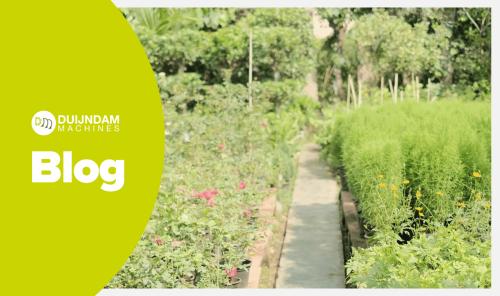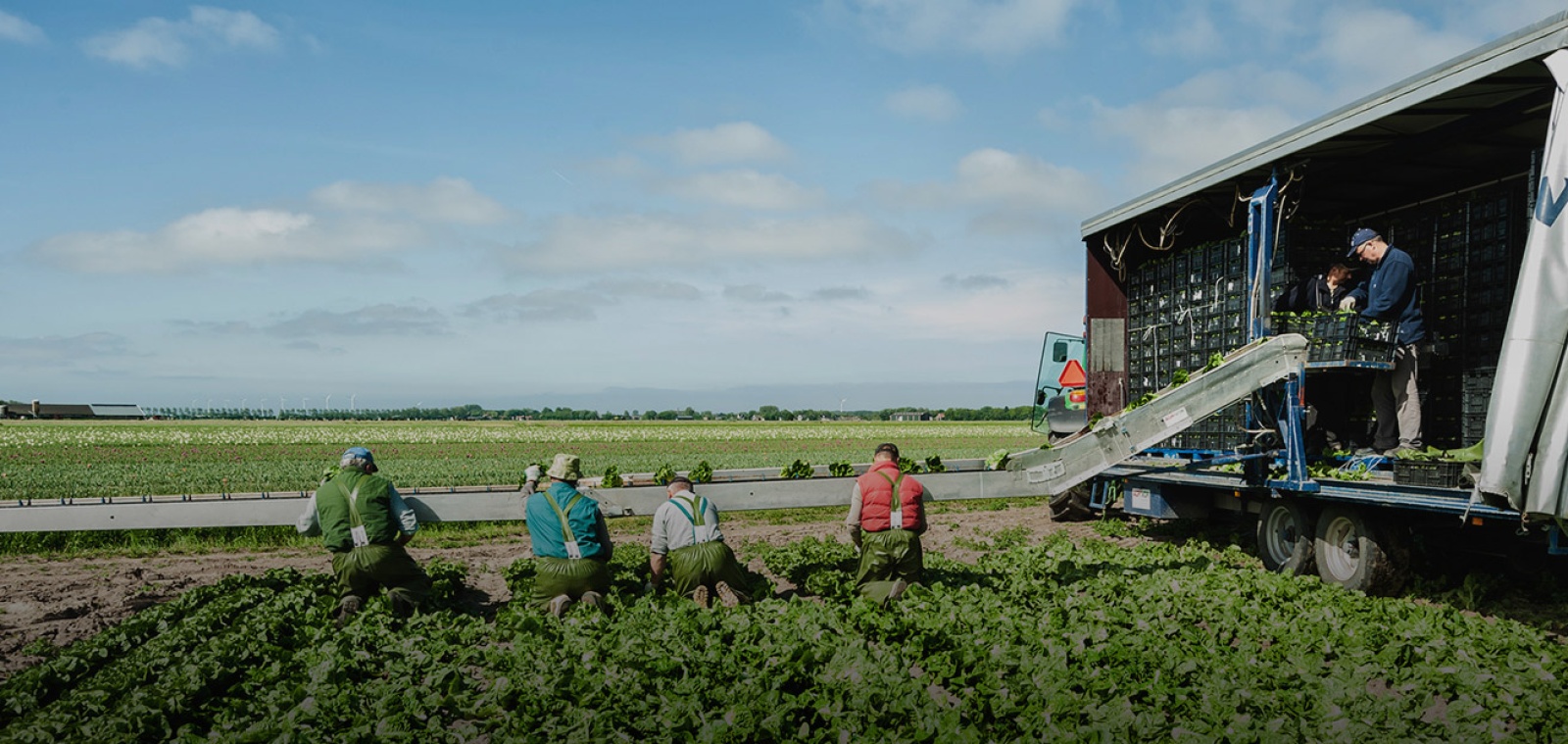Machines for Tree Nurseries

In the Netherlands, there are approximately 1700 tree nurseries (CBS), which is about 3% of the total number of agricultural businesses in the country. This is relatively high compared to the number of cut flower businesses, which is 865, and bulb flower businesses, which number 585. However, these figures reveal little about the production quantities of these businesses.
Tree nurseries cultivate various types of trees and plants, including avenue trees, woodland plants, ornamental shrubs, conifers, fruit trees, perennial plants, and Christmas trees. The cultivation methods vary widely, with some plants growing in open fields, while others are cultivated in containers or pots. The cultivation method depends on the intended use of the plant, and plants can be sold with pot, root ball, or bare root. For each cultivation method, there are different machines to partially or fully mechanize the process, contributing to the efficient and rapid care of trees and plants. This allows tree nurseries to plant, care for, harvest, and transport large quantities of trees in a relatively short time.
What machines are used in tree nurseries?
There are several different cultivation methods, and different stages of cultivation require different machines. This results in a comprehensive list of machines suitable for tree nurseries, including:
- Planting machines
- Disk planters;
- Groove planting machines;
- Plant hole drilling machines;
- Pot machines
- Plant robots
- Weed control machines
- Spading machines
- Hoeing machines
- Pruning machines
- Harvesting machines
- Tree harvesting machines with root ball
- Root ball digging machines
- Root ball harvesting machines
- Tree harvesting machines without root ball
- Harvesting plows with winch
- Offset lifters
- Selective harvesting machines
- Clamp harvester
- Shake lifters
- Bed harvesters
- Machines for Internal Transport
- Forklifts
- Transport carts
- Buffer belts
- Conveyor belts
Planting machines for tree nurseries
Planting machines do exactly what the name suggests; they plant a seedling in the ground. Like other plants, trees need to be planted as small seedlings in their early stages. This is often done using planting machines suitable for planting both bare roots and root balls. For trees, it is particularly important to pay attention to the correct spacing between individual plants. This is even more crucial than for other plants, especially when seedlings need to grow into mature trees before being sold, requiring significant spacing between the plants.
In open-field cultivation, one of the following types of planting machines is often used.
- Disk planters; suitable for planting small trees and rootstocks.
- Groove planting machines; for large trees, olive, almond, and fruit trees, rootstocks, spindles, and conifers.
- Plant hole drilling machines; for drilling planting holes.
Within our assortment, we offer a varied range of planting machines specifically suitable for tree nurseries. If you are looking for a particular model, we recommend checking our selection regularly or subscribing to our email notifications to stay informed about any updates.
Pot machines
Pot machines ensure that trees and plants are placed in pots. This can be for further cultivation or for sale. Empty pots are manually placed or automatically loaded into pot holders, mounted on a wheel, directly under the filling opening or chain conveyor. These pot holders move to the filling opening, where the pots are evenly filled with potting soil, and excess soil can be removed by a leveling unit. After drilling planting holes, the pots go under a pressure drilling unit. With automatic pot drainage, the pots are automatically placed on a conveyor belt. Optimal efficiency is achieved by integrating the pot machine with plant robots, soil supply systems, and potted plant transport systems. Plant robots ensure that a plant is automatically placed in the pot.
(Mechanical) Weed Control Machines
Growers specializing in growing trees and perennial plants in open fields use a variety of agricultural equipment to control weeds, including hoeing machines, row cultivators, harrows, and row sprayers. On the other hand, pot plant growers, cultivating their plants in pots, use bark spreading machines (for spreading bark mulch) and spray wagons with spray booms to effectively control weeds. To deliver plants, pots undergo a cleaning process using pot washing machines, removing moss and other dirt to ensure plants are delivered in optimal and directly saleable condition.
Pruning Machines
Various cutting machines are available for pruning plants and trees, each tailored to specific plants and needs. Specific pruning machines for prunus, boxwood, and yew are designed to cut precisely and create balls or cones, achieving a varied and structured appearance. For the maintenance of taller trees, manual pruning is often applied, using a cherry picker, also known as a pruning platform, to reach the upper parts of the tree. These methods offer a versatile approach to shaping and maintaining plants and trees in tree nurseries.
Harvesting Machines for Plants and Trees
With a suitable harvesting machine, trees and plants can be harvested flexibly, quickly, effectively, and at a favorable cost. Almost every tree grower and cultivator has different preferences when it comes to the harvesting machine. The following types of tree harvesting machines can be distinguished:
Tree harvesting machines with root ball
When harvesting trees, the method of harvesting with a root ball is often applied, with the aim of preserving a significant portion of the tree's roots during transplantation. Maintaining the root ball, also known as the root ball, significantly contributes to the successful survival of the tree after replanting. Various harvesting machines are used to ensure that the root ball remains as intact as possible. These machines include (root ball) digging machines, used for the (semi)automatic digging of conifers, Christmas trees, yews, beeches, boxwoods, and laurels.
In addition, root ball harvesting machines are available, which can be attached to a tractor, hung from a crane, or operate independently on crawler tracks, such as machines manufactured by Pazzaglia and Holmac. The harvesting process involves carefully preserving the root ball, which is essential for the successful transfer of the tree to a new location.
After harvesting the trees, there is the option to cover the root balls with a net using a netting machine. This adds an extra layer of protection to the root ball, contributing to the promotion of the tree's healthy survival after transplantation.
Tree harvesting machines without root ball
- Harvesting plows with winch: These machines are used for effectively undercutting avenue trees, conifers, and forsythias. By using a winch, the harvesting process is optimized, effectively cutting the roots of the trees and preparing them for transplantation.
- Offset lifters: Specifically designed for harvesting taller trees alongside the tractor. Offset lifters use advanced technologies to harvest trees at height accurately and safely, making them suitable for various applications in tree nurseries.
- Selective harvesting machines: These machines are tailored to custom order harvesting. With their adjustable settings and precision, selective harvesting machines ensure that only the desired plants are harvested, enabling an efficient and targeted process.
- Clamp harvester: Specifically developed for harvesting seedlings, spindles, and fruit trees. The clamp harvester uses a clamping system to gently lift the plants from the ground, minimizing root damage during the harvesting process.
- Shake lifters: Available with or without a movable knife, shake lifters are designed to vibrate or shake trees to easily lift them from the ground. These flexible machines adapt to different tree sizes and soil conditions.
- Bed harvesters: Ideal for direct unloading into a cubic box or onto a wagon. These machines are versatile and suitable for harvesting various crops, including strawberry plants, asparagus plants, perennial plants, and certain types of tree nursery crops. They provide an efficient solution for harvesting and moving plants to their destination.
Internal Transport Systems for Tree Nurseries
In tree nurseries, a diverse range of internal transport means is used to facilitate the efficient movement of trees and plants.
Transport carts, equipped with special holders or racks, provide a structured and organized way to transport various plants simultaneously. These carts can be manually propelled or electrically powered, adapting to the specific needs of the nursery.
Forklifts play a crucial role in vertically transporting large and heavy trees. Equipped with special clamps or forks, forklifts ensure a secure grip during lifting and moving of the trees, ensuring safe transport from one location to another.
Buffer belts and conveyor belts form an automated transport solution for smaller plants and seedlings. These advanced systems use smart technologies to guarantee a constant and efficient flow of plant material. Buffer belts serve as a temporary storage station where plants can be stored before being transported to their final destination. Conveyor belts use mechanical movement to transport plants along a predetermined path, increasing labor efficiency.
The combination of these diverse internal transport means within the tree nursery creates an optimized system for managing logistical processes, enabling the nursery to handle plant material efficiently and seamlessly.
Manufacturers of machines for tree nurseries include Damcon, Lommers, Ezendam, Schrauwen, Basrijs, Elco, Javo, and Martin Stolze.
 Request an offer (
Request an offer (